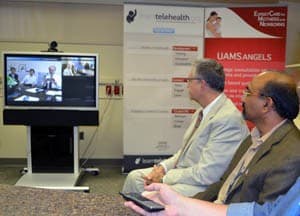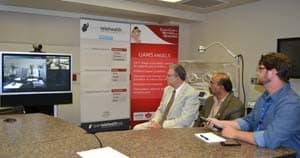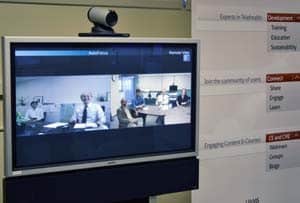UAMS Leads Telemedicine Pilot Program in Japan
| June 1, 2012 | A crisp image of a smiling Japanese man sitting at a desk appeared on the flat screen monitor. “Hello, old friend! How are you?” asked Curtis L. Lowery Jr., M.D., chairman of the Department of Obstetrics and Gynecology at the University of Arkansas for Medical Sciences (UAMS) and founder of the UAMS Center for Distance Health. Nobukazu Nakasato, M.D., Ph.D., a friend and colleague of Lowery’s since 1998, is a neurosurgeon and professor in the Department of Epileptology at Tohoku University School of Medicine in Sendai, Japan. Lowery and the Center for Distance Health international telemedicine coordinator, Hari Eswaran, Ph.D., reached out to Nakasato following last year’s devastating earthquake and tsunami and helped implement the first interactive telemedicine program in the region. “Video conferencing allows UAMS to develop strong collaborations with international educational institutions,” Lowery said. “The goal is to reach the point where we can share advancements in education, research and clinical service among all of our peers in every discipline.” Through a sizeable grant from Polycom, a global leader in secure, easy-to-use video collaboration, the Center for Distance Health was able to donate two, state-of-the-art units to Tohoku University Hospital and to Kensennuma City Hospital, along the coastal area of Japan, still struggling to recover from the tsunami. Construction projects make driving the normally three-hour trip to see a specialist in Sendai much more challenging for patients, some of whom are elderly and cannot pick up and leave to see a doctor. The shinkansen, or high-speed bullet trains, don’t go to the coast. Another issue patients along the coast face is the lack of physicians who offer sub-specialty care. “So, the impact of this system is just great,” said Nakasato, who has consulted with two epilepsy patients and their families through the telemedicine program UAMS helped set up. “Everybody wants to hear about last-minute technical glitches that everyone was able to overcome,” said Dustin Vance, senior video support specialist, who consulted with his counterparts in Sendai and Kensennuma City. “But the technical infrastructure in Japan is so great that Tohoku University Hospital got their unit, took it out of the box, plugged it up — ours was plugged up — and we exchanged numbers and that was it.” UAMS’ Center for Distance Health has entered into similar projects in other international locations, from India to Ecuador, said Hari Eswaran, Ph.D., associate professor in the Department of Obstetrics and Gynecology in the UAMS College of Medicine. “Our goal with this telemedicine project in Japan was to show them that this can be done,” Eswaran said. Sendai is perhaps the ideal location in Japan because, like Vance says, the technical expertise is proven. In fact, Sendai-native and Tohoku University alumnus Dr. Jun-Ichi Nishizawa was the engineer who developed optical fiber communication. Nakasato says earlier telemedicine initiatives in the Sendai region have focused on histopathology and radiology, using only static images. With the Polycom equipment and support from UAMS, physicians at Tohoku University Hospital can talk to the patients and their doctors, and get a magnified view of the medical condition that the naked eye cannot provide. Tohoku University Hospital is eager to set up a comprehensive telemedicine center, like the UAMS Center for Distance Health, to reach as many satellite hospitals as possible and include specialists from other departments, such as dermatology and ophthalmology, Nakasato said. As for the remote epilepsy clinic’s first patient in Kensennuma City, Nakasato reports the patient and her mother felt relieved their physician, Norio Narita, M.D., was able to consult with Nakasato about whether she is a candidate for epilepsy surgery. “There’s no difference to having a real, face-to-face meeting with a patient,” Nakasato said. “I was able to see the non-verbal communication, the emotional state of the patient,” and for epilepsy patients, this is a particularly good thing. Soon, Kazutaka Jin, M.D., from Tohoku University Hospital will be training with the team at the UAMS Center for Distance Health to learn more about standards of care while consulting with patients through telemedicine. “This telemedicine system is perfect,” said Nakasato. |


